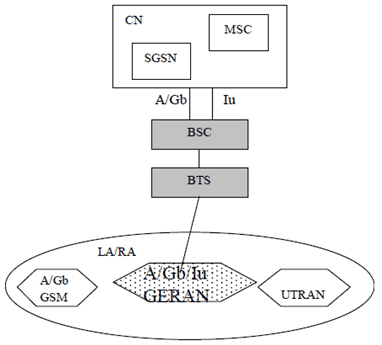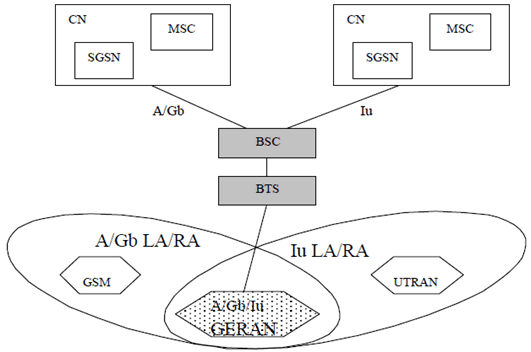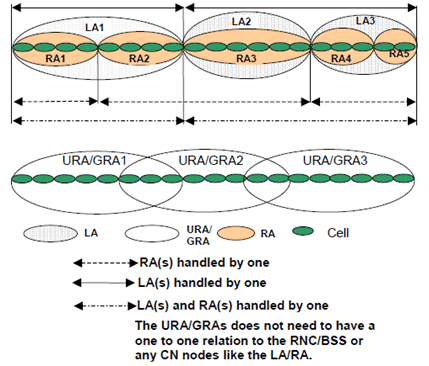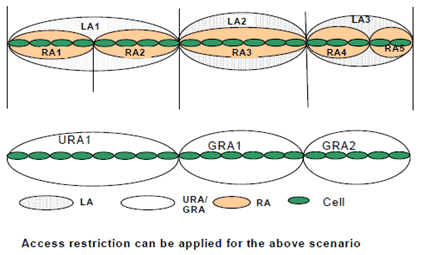Content for TS 23.221 Word version: 18.0.0
6.3 Description of the location management and mobility management concept - area concepts p. 22
6.3.1 Introduction p. 22
For the mobility functionality five different area concepts are used. LA and RA in the CN as well as UTRAN Registration Area, GERAN Registration Area and Cell areas in the RAN.
6.3.2 Location areas p. 22
For CS services, the CN uses LA. LA is used e.g. at CN initiated paging related to CS services. A CS service related temporary identity, CS -TMSI, may be allocated to the UE. This temporary identity is then unique within a LA.
6.3.3 Tracking and Routing areas p. 22
For PS services, the CN uses TA or RA. TA or RA is used e.g. at CN initiated paging related to PS services. A PS service related temporary identity, P-TMSI or S-TMSI, may be allocated to the UE. The P-TMSI is then unique within an RA. The S-TMSI is then unique within one or multiple TAs.
6.3.3a Support of Iu and A/Gb mode of operation in GERAN Cells |R5| p. 22
6.3.3a.1 Overview p. 22
A GERAN capable cell may belong to the same LA/RA for both modes of operation (Figure 6.2a). In the case of a combined CN node supporting both Iu and A/Gb mode MSs, a single LA/RA identity for MSs in either mode shall be broadcasted in the cell since the same LAI and RAI will be used in both modes of operation.

It is also possible for GERAN capable cell to support both A/Gb and Iu mode of operation without any restriction on combined CN nodes (Figure 6.2b). In order to support this GERAN capable cells need to support the possibility to broadcast both LA/RA identities for MSs in Iu mode and for MSs in A/Gb mode. The existing LAI/RAI will be used for mobiles operating in A/Gb mode while the LAI/RAI for Iu mode will be used for mobiles operating in Iu mode. The reason for this is that the LA and RA cannot in this case overlap the both CNs.

6.3.3a.2 Interface selection in GERAN Cells p. 23
The MS shall be able to derive the mode supported in cell from the information broadcasted.
The support of different modes of operation in the MS shall be indicated in the MS Classmark and/or the MS Radio Access Capabilities.
6.3.3a.2.1 Basic principles for MS controlled Cell/Mode selection/re-selection p. 23
The procedures for MS controlled cell selection/re-selection are done according to UMTS/GSM principles and procedures outlined in TS 25.304 and TS 45.008. This means that a GERAN cell will be selected regardless which mode it supports. The cell selection is based on radio criteria and not service.
If a GERAN cell is selected and it is both Iu and A/Gb capable, an Iu and A/Gb capable mobile station shall select Iu mode of operation by default.
6.3.3a.2.2 Basic principles for network controlled Mode selection/re-selection p. 23
The procedures for network-controlled cell selection/re-selection are done according to UMTS/GSM principles. When a cell/mode change is ordered by the network, the mode of operation to apply will be indicated by the network.
6.3.4 RAN internal areas p. 23
RAN internal areas are used by the UTRAN when the terminal is in RRC-Connected mode (see clause 6.7). The areas are used at e.g. RAN initiated paging. RAN internal area updating is a radio network procedure and the RAN internal area structure should not be visible outside the RAN. In RRC connected mode, the UE position is known on cell level or on URA/GRA level. RNTI is used as a temporary UE identifier used within the RAN and allocated at RRC connection establishment.
6.3.5 Relationship between the different areas p. 24
The following area relations exist (see Figure 6.3):
- there need not be any relation between URA/GRA and LA respectively between URA/GRA and RA. The URA concept is defined in TS 25.331 and the GRA concept is defined in TS 43.051;
- one RA consists of a number of cells belonging to RNCs that are connected to the same CN node;
- one LA consists of a number of cells belonging to RNCs that are connected to the same CN node;
- one TA consists of a number of cells belonging to eNodeBs that are connected to the same CN node;
- one RA is handled by only one CN serving node, i.e. one combined MSC+SGSN or one 3G_SGSN, unless "Intra Domain Connection of RAN Nodes to Multiple CN Nodes" is used;
- one LA is handled by only one CN serving node, i.e. one combined MSC + SGSN or one 3G_MSC/VLR, unless "Intra Domain Connection of RAN Nodes to Multiple CN Nodes" is used.
- RA and LA is equal;
- one RA is a subset of one, and only one, LA, meaning that a RA do not span more than one LA.

6.3.5a Restriction of subscribers' access |R6| p. 25
Operators shall be able to restrict their subscriber's access between E-UTRAN, GERAN and UTRAN radio access, via administrative procedures based on subscription information.
In order for the restriction to apply, the network cells shall be organized so that each LA and RA contains either UTRAN or GERAN cells only. TAs apply to E-UTRAN only. Based on the subscription information and the LA/RA/TA information available in the VLR/SGSN/MME, subscriber's access may be rejected during LA/RA/TA update procedure.

Figure 6.3a: Example scenario between different areas for restriction
(⇒ copy of original 3GPP image)
(⇒ copy of original 3GPP image)
The HSS/HLR shall provide the MSC/MSC server/VLR, SGSN and MME with the following information about the subscriber's GERAN and UTRAN access restriction set by the operator determined e.g. by subscription scenario and roaming scenario, as specified in TS 23.008:
- GERAN not allowed.
- UTRAN not allowed.
- WB-E-UTRAN not allowed.
- NB-IoT not allowed.
6.3.6 Hierarchical tracking concept p. 26
This concept applies to UTRAN access only. A packet UE (in RRC connected mode) is tracked at the cell level by RNC during an active connection.
A packet UE (in RRC connected mode) is tracked at the URA level by RNC when no data are actively transfer, and the probability of data transfer is quite high.
A packet UE (in PS-Idle state) is tracked at the RA level by SGSN when no data is actively transferred and the probability of data transfer is quite low. The network operator can optimise paging and updating load by controlling the size of the different areas and the probability of data transfer (controlled by the RRC_connection_release timer). For example, one operator can decide that URA/GRA are small, and that RRC connection are released after a relatively short time of inactivity, so that most attached packet UE are tracked in the RA level (optimum for packet UE mainly using client-server type of service).
Another operator can decide that URA/GRA are large, and that RRC connection are released only if RRC connection is lost, so that most attached packet UE are tracked at the URA level.
The procedure for the releasing of the RRC connection can be found in TS 23.060 under the Iu release procedure. The URA update procedures can be found in TS 25.331 and GRA update procedures can be found in TS 43.051.